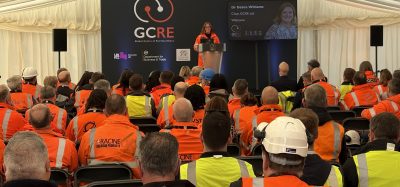The Danish Electrification Programme: A huge commitment
Posted: 18 September 2014 | | No comments yet
The Danish Electrification Programme was established in November 2012 to carry out electrification works initially on four Danish rail sections. Through the ‘Togfonden DK’ initiative five further sections have since been added to the scope of the electrification works, along with funding for additional optional rail sections and associated services. This is a testament to the large commitment to electrification in Denmark and it gives both Banedanmark and the future supplier a possibility to industrialise roll-out and benefit from a programme scale learning curve. Even though the Programme has only existed less than two years, it’s well underway. Søren Thorpstrup Laursen – Head of the Danish Electrification Programme at Banedanmark explains further and how prepatory work on the first two lines is already underway.


The Electrification Programme will create a strong foundation for a modern railway by electrification of major parts of Banedanmark’s network and by upgrading existing electrification systems. This will provide reliable, flexible, interoperable and efficient operation to the benefit of passengers, operators and to the environment.
For various reasons the Danish electrification was stopped in 1996, ending with 22% of the main railways being electrified. The existing Danish system was developed in the 1980s. This system will not form the basis for the new electrification.
The Electrification Programme intends to adopt the most recent and best technologies from comparable projects across Europe. This includes both operation and maintenance issues (through the life-cycle perspective), with consideration of a possible future upgrade of the system.
To that end, the employer considers that appropriate quality, inclusive of reliability, should be reached by purchasing ‘off-the-shelf’ technology. Electrification systems which are already well proven in operation, without unnecessary adaptations, are considered to be the preferred solution from time, cost and risk perspectives.
Scope of the programme
In total, the nine railway sections cover approximately 1,362km of railway (1km of single-track railway counts as 1km and double-track railway as 2km). The railway sections are located across Denmark and when construction is finished, the Electrification Programme will have almost doubled the length of railway with a catenary system in Denmark.
The employer is embarking upon a major expansion of the catenary system for electric trains. The following nine non-electrified railway sections will be covered by the contract:
- Esbjerg–Lunderskov – existing track, 2 x 57km
- Copenhagen–Ringsted – new track, 2 x 60km
- Køge Nord–Næstved – existing track, 45km
- Ringsted–Holeby – existing track, 2 x 115km
- Roskilde–Kalundborg – existing track, 2 x 56km
- Fredericia–Aarhus – existing track, 2 x 109km
- Aarhus–Aalborg – existing track, 2 x 140km
- Vejle–Struer – existing track, 130km
- Aalborg–Frederikshavn – existing track, 85km
In addition to the nine aforementioned sections, there is provision in the contract to include an option for electrification of further existing, not yet electrified, or new, not yet decided, railway. Such optional sections might cover (but are not limited to):
- A new railway across Vestfyn
- A new railway across Vejle Fjord
- A new railway from Hovedgård to Hasselager
- A new railway from Lindholm to Aalborg Airport
- A new railway from Hjørring to Hirtshals
- A new railway from Jelling to Billund.
The additional optional sections may potentially cover approximately 300km of railway.
A new electrification system and the functional approach
The Danish Electrification Programme is to also get a new modern and cost effective electrification system. As electrification in Denmark was stopped a number of years ago, Banedanmark have recent knowledge regarding bulk electrification, and the existing system has never been TSI approved.
It is therefore the objective to use a functional tender, to specify what is important for Banedanmark and then let the market and the innovative suppliers decide what the best technical and most cost effective solution is.
The objectives of the Electrification Programme include:
- a) The delivery of an electrification system with an appropriate level of quality in terms of functionality and reliability
- b) The delivery of the most economically advantageous electrification system taking consideration of the required quality of the system both from the initial delivery and over the full life-cycle of the electrification system
- c) The delivery of an electrification system within the set programme timeline meeting both the project needs and the political requirements
- d) The delivery of an electrification system that avoids or minimises modifications to existing infrastructure, i.e. bridges etc.
- e) The identification and mitigation of risks to the Electrification Programme that may impact on time, quality, reliability and cost
- f) A contractor who has the strength and depth in organisation and infrastructure to address the different sections including existing sections which have to be electrified and also those which are totally new
- g) A contractor with the necessary experience, expertise, organisation and infrastructure to ensure the appropriate management of the necessary interfaces with the existing system
- h) A contractor who, through in-depth experience, has the ability to undertake the electrification of the railway sections with minimum disruption to other programmes, train services and stakeholders.
Banedanmark is currently in the process of tendering the main contract covering the bulk of the electrification works, excluding the prepatory works from line to line. Contract notice was released on 16 December 2013 and the tender material was released to the five prequalified bidders on 1 May 2014.
Banedanmark are using the negotiated procedure, which gives flexibility and feedback possibilities. Banedanmark will receive the First Negotiation Tenders from the bidders on 3 September 2014. The contract is expected to be signed in the spring of 2015.
Due to the commercial nature of the tender procedure, Banedanmark can not disclose more detailed information from this process.
The sections
Section 1: Esbjerg–Lunderskov (2 x 57km in 2015)
This section is planned to have an early deployment and will be used as a reference for the following phases of the project. This railway section has approximately 57km of double-track alignment, including seven stations, from Lunderskov to Esbjerg (excluding Lunderskov station which is already electrified).
This line travels through a flat area. The starting point for the electrification scope is located approximately 800m after Lunderskov station where the new catenary system will connect to the existing system.
Section 2: Copenhagen–Ringsted (2 x 60km in 2017)
This railway section is located in flat terrain in a new alignment between Copenhagen, Køge and Ringsted is increasing the capacity in and out of Copenhagen for westbound and southbound traffic. Train speeds up to 250km/h require a TSI approved catenary system.
This railway section has approximately 54km of double-track including one new station at Køge North, which is located at the 30km-mark. The alignment generally follows in the same corridor as two of the major motorways. It starts at the electrified line near Ny Ellebjerg/Vigerslev in Copenhagen, goes to the new station Køge North and continues to the existing station at Ringsted, which already is electrified.
Section 3: Køge Nord–Næstved (45km in 2018)
This railway section has approximately 45km of single-track, including seven stations, from Køge Nord to Næstved (excluding Køge Nord and Næstved stations which are part of København–Ringsted and Ringsted–Holeby projects respectively). This section is located on the east side of Denmark.
Section 4: Ringsted–Holeby (2 x 115km in 2019 and 2021)
The line section between Ringsted and Holeby/Femern is abbreviated ‘Rg-Hby’. The civil works and railway upgrading project is abbreviated ’RFB’ and comprise realignments at Glumsø and construction of a second track from New Storstrømsbridge to Holeby. New bridges will be built long the entire section to accommodate both the catenary system (overpasses) and the railway second track. It is designed as a medium speed line (up to 200km/h) in existing alignment.
It starts at the already-electrified line at Ringsted Station, goes through Næstved, Vordingborg, over the new (planned) Storstrømsbridge and continues to the existing station at Nykøbing Falster and ends at the new Holeby Station near Rødbyhavn. At this point it connects to the planned submersible tunnel project called Femernbelt (coast to coast). The length of the double-track section is 112.6km.
Section 5: Roskilde–Kalundborg (2 x 56km)
The starting point of electrification is just south of Roskilde station (at km 34+000, where the new catenary system will connect to the existing system) and ends in Kalundborg station.
It is designed mainly as a single-track line, but an ongoing project is expanding the line to double-tracks between Lejre and Vipperød. When the electrification project is to be executed, there will be double-tracks from Roskilde to Holbæk, and single-track from Holbæk to Kalundborg. A total of 112km of tracks is to be electrified.
Section 6: Fredericia–Aarhus (2 x 109km)
The electrification of section Fredericia–Aarhus is defined as the section from the exit signal at Fredericia station to the exit signal at Aarhus station.
The section is planned to be deployed as the subsequent part of the section Fredericia–Aarhus and Aarhus–Aalborg. This railway section has approximately 110km of double-track alignment, including 11 stations from Fredericia to Aarhus (Fredericia station not included). It starts from the exit signal on Fredericia station and ends in Aarhus station.
Section 7: Aarhus–Aalborg (2 x 140km)
The electrification of section Aarhus–Aalborg is defined as the section from the exit signal at Aarhus station to the exit signal on Lindholm station. The adjacent section from Fredericia station up to and including Aarhus station is part of the electrification of section Fredericia–Aarhus.
The section is planned to be deployed as the subsequent part of the section Fredericia–Aarhus and Aarhus–Aalborg. This railway section has approximately 140km of double-track alignment, including eight stations from Lindholm to Frederikshavn (Lindholm station not included). It starts from the exit signal on Aarhus station and ends at Lindholm station.
Section 8: Vejle–Struer (130km)
The electrification of section Vejle–Struer is defined as the section from the exit signal at Vejle station to the exit signal at Struer station. The section is planned to be deployed as the subsequent part of the Fredericia–Aarhus section and the Aarhus–Aalborg section. This railway section has approximately 126km of single-track alignment, including 17 stations from Vejle to Struer (Vejle station not included). It starts from the exit signal on Vejle station and ends in Struer station.
Section 9: Aalborg–Frederikshavn (85km)
The electrification of section Aalborg–Frederikshavn is defined as the section from the exit signal at Lindholm station to Frederikshavn station. The adjacent section from Aalborg station up to and including Lindholm station is part of the electrification of section Aarhus–Aalborg.
The section is planned to be deployed as the subsequent part of the Fredericia–Aarhus section and the Aarhus–Aalborg section. This railway section has approximately 8km of single-track alignment, including eight stations from Lindholm to Frederikshavn (Lindholm station not included). It starts from the exit signal on Lindholm station and ends in Frederikshavn station.
Biography
Søren Thorpstrup Laursen is Head of the Danish Electrification Programme. He is educated as a Power Systems Engineer, and has worked in the electric utility business for over 15 years. He started working for Banedanmark in November 2012, building up the Electrification Programme.






